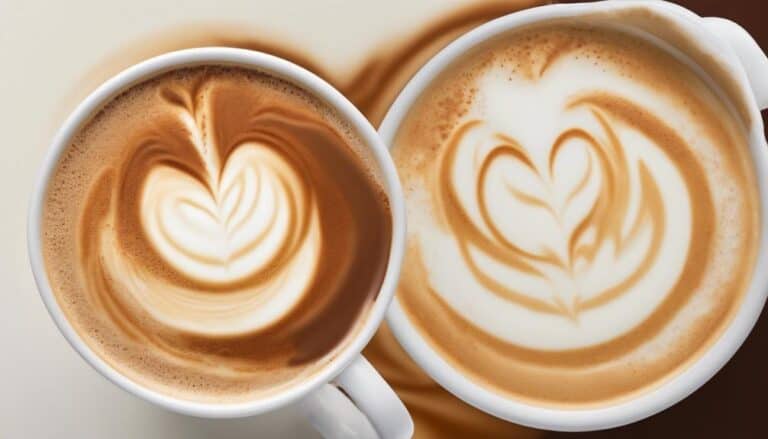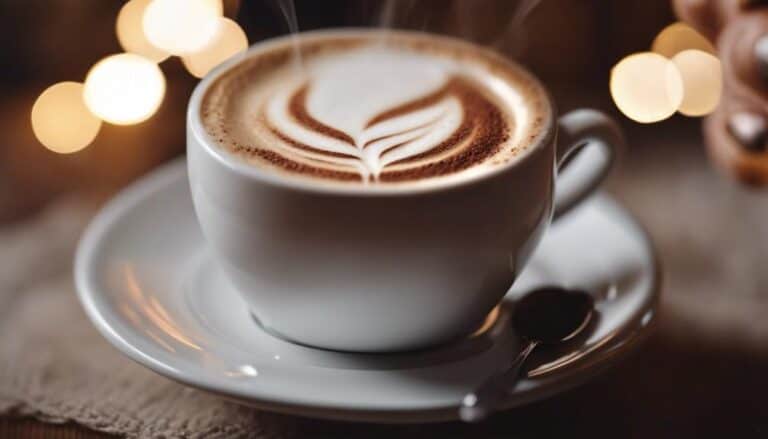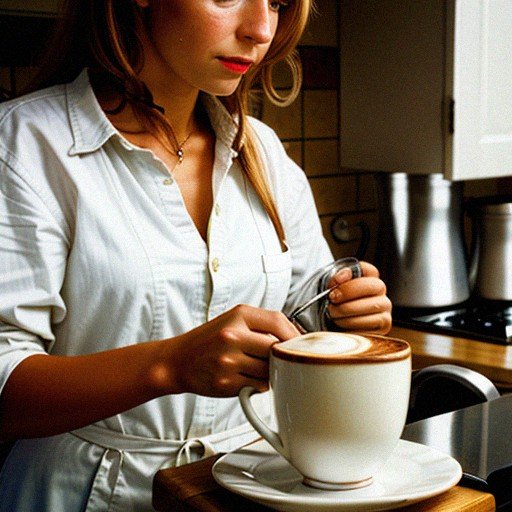Does a Latte or Cappuccino Have More Caffeine? Find Out Here

So, you're sipping on your latte or cappuccino, wondering which one gives you that extra caffeine boost to power through the day.
Well, let's break it down for you. The debate over caffeine content between these two popular espresso-based drinks might surprise you.
Let's uncover the truth about which one reigns supreme in the caffeine department.
Caffeine Content in a Latte
When examining the caffeine content in a latte, it's crucial to consider the varying serving sizes and the impact of espresso shots on the overall caffeine levels. A 16-ounce serving of a latte typically contains around 173 mg of caffeine, while a 12-ounce latte has approximately 155 mg. The mild coffee flavor in lattes is a result of their high milk content, making them a popular choice for those who prefer a creamier and less intense coffee experience. Espresso shots play a significant role in elevating the caffeine levels in lattes, adding to the energy boost they provide.
Comparing lattes to cappuccinos, both beverages have similar caffeine content, with around 173 mg per serving. This makes them equally potent in terms of caffeine intake. Understanding the caffeine levels in lattes is essential for individuals who are mindful of their caffeine consumption but still desire a flavorful coffee drink with a velvety texture.
Caffeine Content in a Cappuccino
In analyzing the caffeine content of a cappuccino, it's crucial to acknowledge its similarity in caffeine levels to that of a latte, typically containing around 173 mg per 16-ounce serving.
A cappuccino differs from a latte in that it's made using equal parts of espresso, steamed milk, and foam, resulting in a smaller amount of milk compared to a latte. This smaller milk content in a cappuccino allows the espresso flavor to shine through, giving it a stronger coffee taste.
The espresso shots in a cappuccino also contribute to its higher caffeine levels, providing a balanced caffeine kick. The small layer of milk in a cappuccino not only enhances its texture but also helps maintain a stronger flavor profile, making it a popular choice for those seeking a rich coffee experience with a moderate caffeine boost.
Factors Affecting Caffeine Levels
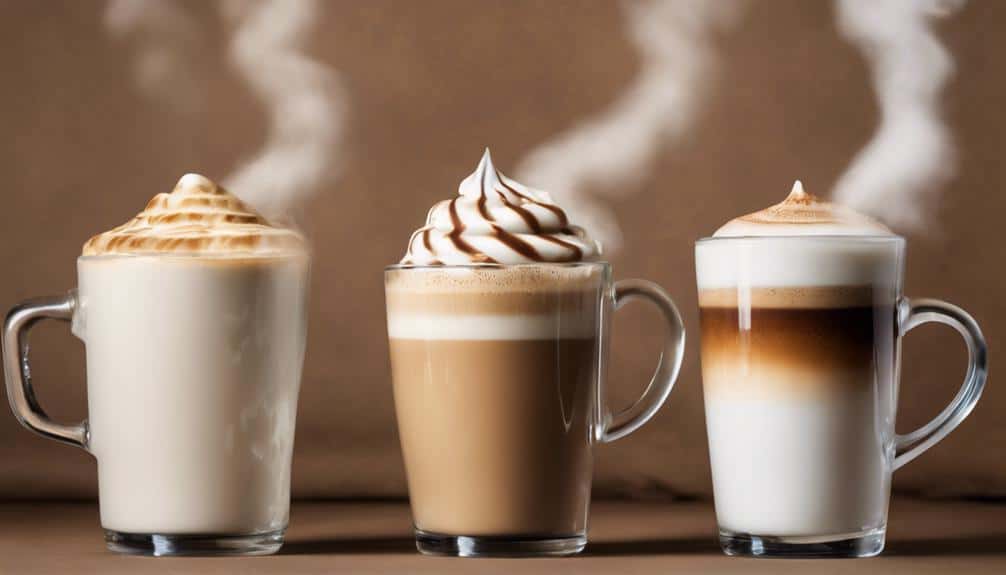
Given the intricate interplay between the composition of espresso, milk, and foam in both lattes and cappuccinos, understanding these elements is pivotal in deciphering their respective caffeine levels.
The espresso content in these beverages plays a significant role in determining the caffeine levels, with lattes typically containing more espresso than cappuccinos. As the steamed milk and foam in cappuccinos slightly dilute the caffeine content in comparison to lattes, the espresso-to-milk ratio is a crucial factor to consider.
For instance, a 12-ounce cappuccino may have around 75 mg of caffeine, while a 12-ounce latte can contain approximately 155 mg. Generally, both drinks have a caffeine content of about 173 mg in a 16-ounce serving.
Comparing Latte and Cappuccino Caffeine
Analyzing the caffeine comparison between lattes and cappuccinos reveals notable distinctions in their espresso-to-milk ratios and resulting caffeine levels. When looking at a 16-ounce serving of both beverages, it's interesting to note that they contain approximately 173 mg of caffeine, showcasing their similar caffeine content. However, diving deeper into the details, a 12-ounce cappuccino contains about 75 mg of caffeine, while a latte of the same size boasts around 155 mg. This variance can be attributed to the differing amounts of steamed milk in each drink. Macchiatos, on the other hand, have lower caffeine levels compared to lattes and cappuccinos due to their lower milk content.
To further illustrate the comparison, the table below outlines the key differences between lattes and cappuccinos in terms of caffeine content:
| Caffeine Comparison | Latte | Cappuccino |
|---|---|---|
| Espresso Content | More | Less |
| Steamed Milk Content | More | Less |
| Frothed Milk Content | Less | More |
| Caffeine Levels | Higher | Lower |
| Popular Choice Among | Coffee Lovers | Coffee Lovers |
Tips for Choosing Based on Caffeine
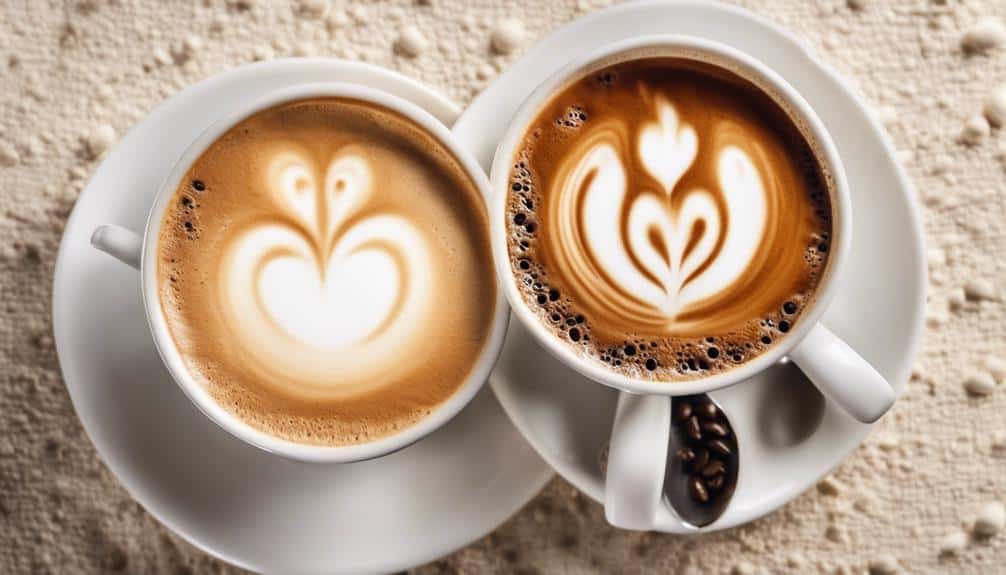
When considering the caffeine content in your coffee choice, a helpful tip is to assess the milk-to-espresso ratio in lattes and cappuccinos. Both lattes and cappuccinos contain around 173 mg of caffeine in a 16-ounce serving, as they use similar amounts of espresso shots.
The difference in caffeine levels between these two beverages and macchiatos, which contain 85 mg of caffeine in a 2-ounce serving, is primarily due to the amount of milk added. Cappuccinos consist of equal parts of steamed milk, milk, and espresso shots, providing a strong coffee flavor with a frothy texture. On the other hand, lattes contain more steamed milk, resulting in a creamier and milder taste.
When choosing based on caffeine, both lattes and cappuccinos offer a similar caffeine kick, making the decision more about the desired milk and coffee balance in your drink.
Conclusion
In conclusion, when comparing the caffeine content of a latte and a cappuccino, both beverages offer a similar amount of caffeine per serving.
The key difference lies in the ratio of espresso to milk, which affects the overall flavor profile of each drink.
Ultimately, the choice between a latte and a cappuccino comes down to personal preference for either a stronger coffee kick or a smoother, creamier experience.
